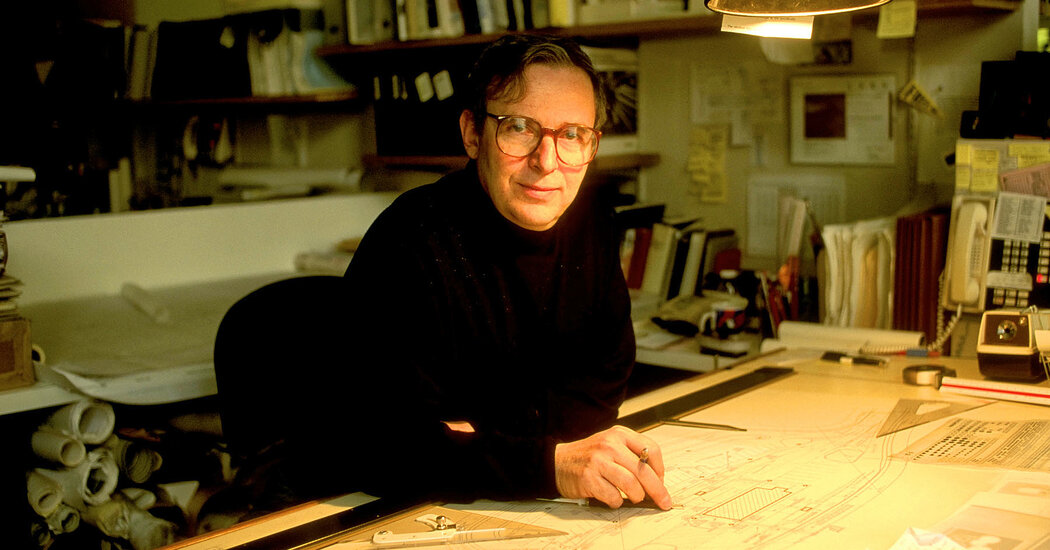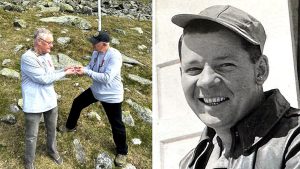Paul Marantz, a prominent architectural lighting designer who illuminated disco floors and skylines, libraries and chic hotels, train stations and concert halls, museums and embassies, died on May 26 at his home in Manhattan. He was 87.
The cause of death was complications of a stroke, his wife, Jane Marantz, said.
Mr. Marantz, who was known as the Prince of Darkness by industry wags, cast a wide net.
His projects, sometimes done in concert with his business partners, Charles Stone and the Tony Award-winning lighting designer Jules Fisher, included new buildings — the Sainsbury Wing of the National Gallery in London (1991), the Rock & Roll Hall of Fame in Cleveland (1995), the Getty Center in Los Angeles (1997), the Museum of Islamic Art in Qatar (2008), the Barnes Foundation in Philadelphia (2012) — as well as many venerable old structures.
Mr. Marantz was involved, for example, in the renovations of Carnegie Hall (1987), Grand Central Terminal (1998), the Rose Main Reading Room of the New York Public Library (1998) and David Geffen Hall at Lincoln Center (2022). He also did the lighting for New York nightclubs like Studio 54 (1977) and the Palladium (1985), and for the Times Square Ball at the center of the New Year’s Eve countdown in Manhattan (1999).
When his firm, Fisher Marantz (now Fisher Marantz Stone), was engaged in 1988 to develop guidelines for the brightness levels of illuminated signs around West 42nd Street, as new office towers were going up in the area, Mr. Marantz came up with the idea of the “luts” (or light unit Times Square) meter — a single-lens reflex camera with a specially modified zoom lens — to measure compliance. And he and his partners were the megawatt wizards who, in 2002, helped realize Tribute in Light, the 9/11 memorial in Lower Manhattan with two luminous columns built on 88 searchlights. (Mr. Marantz’s firm continues to be involved in the annual commemoration.)
“He didn’t invent the field of architectural lighting, but he had enough of a presence in New York that people said, ‘Get me Paul Marantz,’” Tyler Donaldson, a retired architect and project manager who worked with Mr. Marantz on the renovations of Carnegie Hall and the Park Avenue Armory, said in an interview.
“Architects loved working with him because he understood that we wanted the light not just to be functional but to help shape a space and make it more beautiful,” Mr. Donaldson continued. “He also knew that sometimes a space needed to be lit in a way that made it more dramatic or more inviting. Lighting was spotty without him.”
But Mr. Marantz, who won awards from the American Institute of Architects, the Illuminating Engineering Society and the International Association of Lighting Designers, was also very attuned to the role — and power — of light’s absence. One of his favorite books, his son Nicholas said in an interview, was “In Praise of Shadows” (1933), by Jun’ichirō Tanizaki, a treatise on Japanese aesthetics that Mr. Marantz considered “the lighting designer’s basic text.”
“Paul would pause with a gentle smile, point a finger upward and exclaim, ‘Consider the dark!’” his partner Mr. Stone said. “That notion is rooted in the theatrical and architectural lighting that was the heart of his philosophy about lighting.”
In 1977, when Ian Schrager, now largely known as a hotelier, was looking for someone to do the lighting for a new nightclub he was creating with his business partner, Steve Rubell, on West 54th Street in Manhattan, “we went to all the usual suspects,” Mr. Schrager said in an interview. Then Mr. Marantz came by to take a look at the site.
“I saw this professorial-looking guy; he had a beard and a big coat and glasses,” Mr. Schrager said. “I didn’t know if he would be interested.”
But it was Mr. Marantz, Mr. Schrager said, who came up with the idea of treating the space — the future Studio 54 — as the theater it had once been, and created an apposite lighting design: dynamic, vibrant and very dramatic.
The blend of neon, moving lights, flashing lights and light bars was a departure from conventional after-dark aesthetics. “The direction that Studio took was all Paul’s idea,” said Mr. Schrager, who later hired Mr. Marantz to work on several hotels and houses.
“Lighting is such an ethereal discipline,” Mr. Schrager said. “It’s difficult to find people with the architecture and design sense Paul had. He opened up my awareness and my sense of possibilities.”
Mr. Marantz, however, did not become a Studio 54 habitué. “We were not nightclub people,” Ms. Marantz said, while acknowledging a visit or two. “Paul went in, did the work and left through the back door.”
Paul Murat Marantz was born on April 27, 1938, in Elizabeth, N.J., and grew up in Union and Maplewood, N.J. He was the eldest of three children of Samuel Marantz, a lawyer, and Mildred (Goldstein) Marantz, a former teacher who managed the household.
Paul became interested in lighting design at age 10, when he attended a marionette workshop. Inspired, he built a model theater. During high school, he ran lights for dance recitals at a local Jewish community center.
At Oberlin College, in Ohio, he studied architectural and art history, and was active in the theater department. After earning his bachelor’s degree in 1959, he did graduate work at Case Western Reserve University and Brooklyn College, but left without an advanced degree.
He was working for a New York lighting manufacturer in the mid-1960s, designing small light fixtures for window displays, when he met Mr. Fisher, a fellow lighting designer laboring on low-budget shows in Off Broadway theaters.
“I would go to Paul for lighting solutions, or to ask which lights he had or which ones he could design,” Mr. Fisher said in an interview. “And in 1971, I asked, ‘Would you like to be partners?’ because we had similar interests and attitudes. He would always say, ‘Let’s try to find out what the problem is before we solve it.’ And that was a good way to start.”
“Paul was a genius at solving problems of light,” Tod Williams, an architect who frequently collaborated with Mr. Marantz, said in an interview.
At the Barnes Foundation building, designed by Mr. Williams’s firm, Tod Williams + Billie Tsien, some of the windows were initially covered to protect the art. But Mr. Marantz figured out how to bring in natural light while shielding the art, by using controls on the roof that monitored the sun’s position. “His thinking was analog,” Mr. Williams said. “But he used digital tools.”
Analog? Digital? Mr. Marantz sometimes made do with whatever was at hand. One long-ago Thanksgiving, when the family lived in a house in New Jersey designed by Gustav Stickley, Ms. Marantz said in an interview, he conjured up an Arts-and-Crafts-style light fixture for the dining room with a few pieces of wood he had stained in his home workshop. He fashioned the shade from the pages and binding of a spiral notebook.
In addition to Ms. Marantz, whom he married in 1977, and their son, Nicholas, Mr. Marantz is survived by another son, Joshua, from a previous marriage, to Marsha Heller, that ended in divorce; four grandchildren; a brother, Robert; and a sister, Ellen Florin.
Shoemakers’ families often go barefoot. Years ago, when the daughter of a family friend returned home after babysitting Nicholas Marantz, “she told her parents, ‘I thought he was in the lighting business. I couldn’t find a good place to read,’” Ms. Marantz recalled.
She added: “In the end, we had gorgeous light. But it took a while, because it mattered so much to Paul.”











